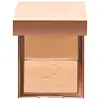Patrick Ta Major Skin Crème Foundation and Finishing Powder Duo Versus Patrick Ta Major Sculpt Contour Brush
What's inside
What's inside
 Key Ingredients
Key Ingredients

No key ingredients
 Benefits
Benefits

No benefits
 Concerns
Concerns

No concerns
 Ingredients Side-by-side
Ingredients Side-by-side

Lac Powder
Skin ConditioningSilica
AbrasiveMica
Cosmetic ColorantLauroyl Lysine
Skin ConditioningZinc Stearate
Cosmetic ColorantNylon-12
Kaolin
AbrasiveOctyldodecyl Stearoyl Stearate
EmollientDimethicone
EmollientPolymethylsilsesquioxane
Polysilicone-11
Isononyl Isononanoate
EmollientMagnesium Myristate
Magnesium Ascorbyl Phosphate
AntioxidantAnthemis Nobilis Flower Water
MaskingTocopheryl Acetate
AntioxidantSodium Benzoate
MaskingPotassium Sorbate
PreservativeCaprylyl Glycol
EmollientPhenoxyethanol
PreservativeCitric Acid
BufferingHexylene Glycol
EmulsifyingLaureth-12
EmulsifyingTriethoxycaprylylsilane
CI 77891
Cosmetic ColorantCI 77491
Cosmetic ColorantPPG-3 Benzyl Ether Myristate
EmollientEthylhexyl Isononanoate
EmollientDivinyldimethicone/Dimethicone/Phenylsilsesquioxane Crosspolymer
Polyethylene
AbrasivePentaerythrityl Tetraisostearate
EmollientBis-Stearyl Dimethicone
EmollientButyl Acrylate/Hydroxypropyl Dimethicone Acrylate Copolymer
Ethylhexyl Palmitate
EmollientIsopropyl Myristate
EmollientLecithin
EmollientPolyhydroxystearic Acid
EmulsifyingPolyglyceryl-10 Polyricinoleate
EmulsifyingPentaerythrityl Tetra-Di-T-Butyl Hydroxyhydrocinnamate
AntioxidantIsostearic Acid
CleansingLac Powder, Silica, Mica, Lauroyl Lysine, Zinc Stearate, Nylon-12, Kaolin, Octyldodecyl Stearoyl Stearate, Dimethicone, Polymethylsilsesquioxane, Polysilicone-11, Isononyl Isononanoate, Magnesium Myristate, Magnesium Ascorbyl Phosphate, Anthemis Nobilis Flower Water, Tocopheryl Acetate, Sodium Benzoate, Potassium Sorbate, Caprylyl Glycol, Phenoxyethanol, Citric Acid, Hexylene Glycol, Laureth-12, Triethoxycaprylylsilane, CI 77891, CI 77491, PPG-3 Benzyl Ether Myristate, Ethylhexyl Isononanoate, Divinyldimethicone/Dimethicone/Phenylsilsesquioxane Crosspolymer, Polyethylene, Pentaerythrityl Tetraisostearate, Bis-Stearyl Dimethicone, Butyl Acrylate/Hydroxypropyl Dimethicone Acrylate Copolymer, Ethylhexyl Palmitate, Isopropyl Myristate, Lecithin, Polyhydroxystearic Acid, Polyglyceryl-10 Polyricinoleate, Pentaerythrityl Tetra-Di-T-Butyl Hydroxyhydrocinnamate, Isostearic Acid